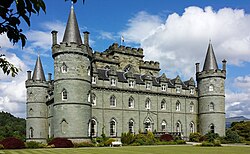This article needs additional citations for verification .(September 2022) |
The Duchess of Argyll is typically the wife of the Duke of Argyll, an extant title in the Peerage of the United Kingdom created in 1892. The Duke [1] is also Duke of Argyll in the Peerage of Scotland, which was originally created in the 1701.
Contents

The family seat is Inveraray Castle near Inveraray in the county of Argyll, in western Scotland.